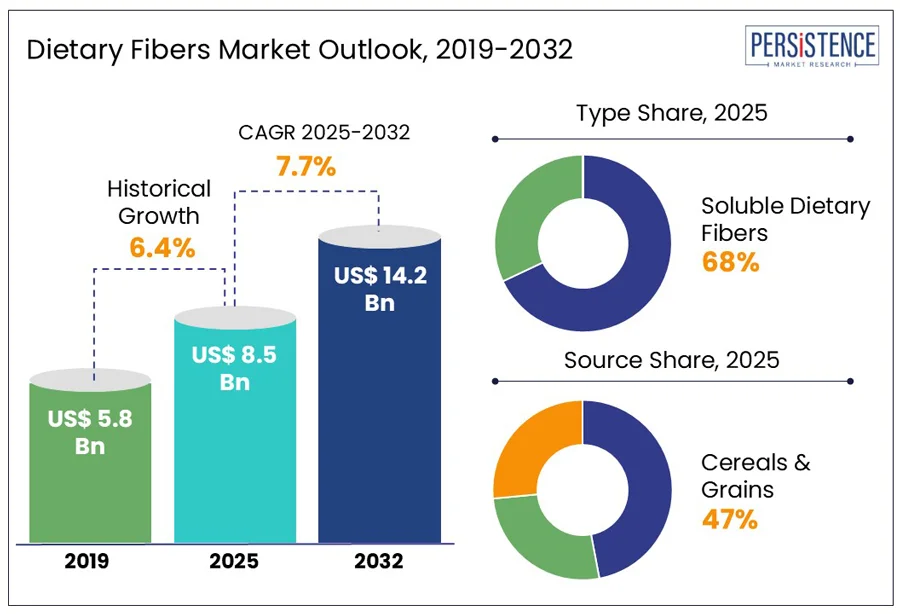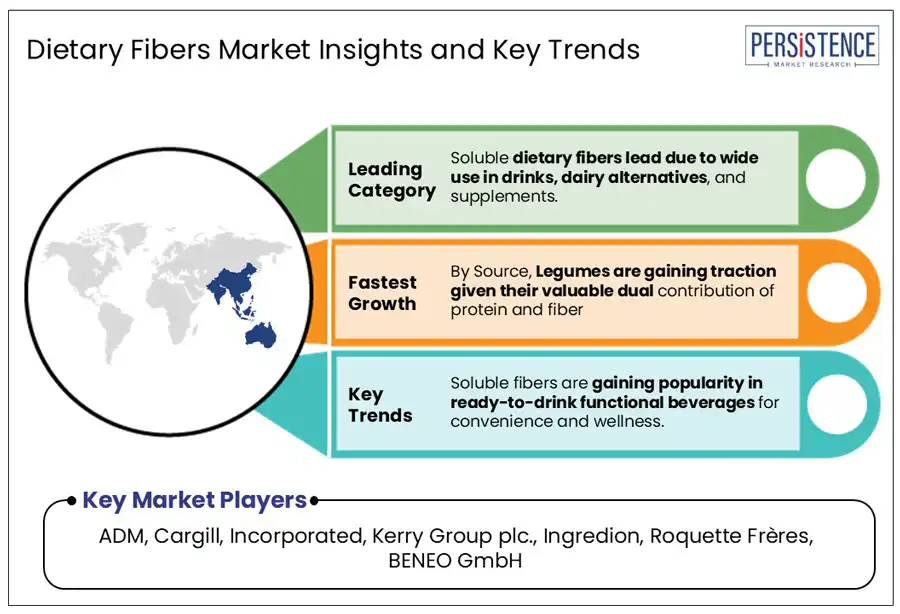ID: PMRREP29581| 200 Pages | 12 Jun 2025 | Format: PDF, Excel, PPT* | Food and Beverages

The global dietary fibers market size is estimated to grow from US$ 8.5 billion in 2025 to US$ 14.2 billion by 2032. The market is projected to record a CAGR of 7.7% during the forecast period from 2025 to 2032.
According to Persistence Market Research, the global dietary fibers industry is poised for notable growth, driven by rising gut health awareness, sports nutrition innovation, and the shift toward clean-label ingredients. Emerging markets are accelerating adoption, while fiber blends tailored for metabolic health and personalized nutrition are shaping future opportunities.

Key Industry Highlights:
|
Global Market Attribute |
Key Insights |
|
Global Dietary Fibers Market Size (2025E) |
US$ 8.5 Bn |
|
Market Value Forecast (2032F) |
US$ 14.2 Bn |
|
Projected Growth (CAGR 2025 to 2032) |
6.4% |
|
Historical Market Growth (CAGR 2019 to 2024) |
7.7% |
Chronic diseases, or non-communicable diseases, stand as a primary cause of death among adults globally. With accelerating urbanization, individuals are increasingly adopting sedentary lifestyles, which is subsequently pushing up obesity rates and the incidence of chronic diseases. Dietary fibers are proving instrumental in managing and preventing these conditions, including diabetes, cardiovascular diseases, metabolic syndrome, diverticular disease, obesity, colorectal cancer, and inflammatory bowel syndrome. Insoluble fiber, for example, binds to the bloodstream and effectively adsorbs mutagens, carcinogens, and other toxins, thereby preventing harmful effects on the body by facilitating their elimination. Furthermore, foods rich in soluble fibers, such as oatmeal, beans, nuts, and apples, aid in regulating the body's use of sugar, which helps control hunger and stabilize blood sugar levels. Thus, the growing awareness and increased consumption of dietary fibers for promoting a healthy life are significantly driving the market for these products. According to the WHO, chronic disease prevalence was recorded at 57% in 2020, underscoring the critical need for such dietary interventions.
Dietary fibers are commonly found in sources such as legumes and whole grains, including cereals, wheat bran, and brown rice, many of which contain gluten. However, gluten intolerance has become one of the most frequent food sensitivities among consumers today. Consequently, gluten-free diets are gaining immense popularity due to perceived benefits such as improved health, higher energy levels, and weight loss. As the number of people sensitive to gluten-containing foods continues to rise, the overall demand growth for certain dietary fibers could be hampered. Furthermore, various diseases linked to gluten consumption, such as infertility, celiac disease, and neurological disorders, pose another significant restraint. With the increasing prevalence of celiac disease, the rising consumption of gluten-free food products might directly hinder the growth of the broader dietary fibers market.
The recognized health benefits of dietary fibers, including their role in reducing diabetes, obesity, and cholesterol, have significantly surged their demand, particularly within nutraceutical products. Dietary fibers are also crucial for maintaining optimal gut health; soluble fibers soften stools, while insoluble fibers add bulk, ensuring bowel movement regularity and preventing constipation by aiding waste transit. Beyond general wellness, dietary fibers are highly beneficial for athletic performance, enhancing muscle function, endurance, and regeneration both before, during, and after training. This confluence of benefits is opening new doors for dietary fiber manufacturers in the nutraceutical and sports nutrition industries. For instance, Kerry Group’s EmulGold fiber, a stable spore-forming prebiotic ingredient that can be seamlessly integrated into a wide range of products, including food and beverage items, snacking bars, nutraceutical tablets, confectionery, sauces, and ready meals, highlights the versatility and market readiness of such tailored solutions.
Soluble dietary fibers currently hold a dominant 68% market share in 2025, a leading position primarily fueled by their widespread use in functional beverages, dairy alternatives, and a burgeoning supplement sector. Their versatility stems from properties such as gelling, thickening, and their ability to get incorporated into various matrices without significantly altering taste or texture. Consumers are increasingly drawn to products enriched with soluble fibers due to their proven benefits in blood sugar regulation, cholesterol reduction, and prebiotic effects that foster a healthy gut microbiome. The convenience of consuming these fibers through popular product formats, from fortified juices to plant-based milks and daily supplements, further solidifies their market leadership as health-conscious consumers seek easy ways to boost their fiber intake for overall wellness.
While soluble fibers lead, insoluble dietary fibers are experiencing a growing demand. They are increasingly recognized for their critical role in promoting digestive regularity, preventing constipation, and adding bulk to the diet, which aids in satiety. This growing awareness of their distinct benefits ensures a complementary, rather than competing, growth trajectory in the overall dietary fiber market.
Legumes are expected to grow at a CAGR of 8.4% during the forecast period 2025 to 2032, gaining significant traction given their valuable dual contribution of protein and fiber. Traditionally, dietary fibers are majorly sourced from fruits and vegetables, legumes, and cereals & grains, with cereals & grains, including rice and wheat, holding a significant 47% value share of the global market.
The appeal of legumes, however, lies in their inherent ability to provide both essential macronutrients, making them incredibly efficient for nutritional fortification. Food manufacturers are increasingly leveraging this, often fortifying or enriching cereal-based products with additional dietary fibers to enhance their nutritional profile. This includes incorporating fiber-rich ingredients such as bran, whole grains, and resistant starch into popular items such as bread, breakfast cereals, and snacks, catering to health-conscious consumers seeking complete nutritional benefits from their food choices.

North America boasts a strong and consistent growth rate in the dietary fibers market, largely driven by an increasing emphasis on healthier living, especially post-COVID-19. Despite this trend, a significant gap remains, as evidenced by the American Society for Nutrition's finding that only 5% of men and 9% of women in U.S. are consuming the recommended daily amount of dietary fiber, consequently raising the risk of chronic diseases. This awareness of nutritional deficiencies, coupled with growing knowledge about general wellness, is fueling demand.
Product innovation and developments in dietary supplements are also playing a crucial role, making fiber consumption more accessible and appealing. Regulatory support from the U.S. FDA further instills consumer confidence and facilitates market expansion. The U.S. stands out as a key importing country of cereals and grains, a major source of dietary fibers.
Moreover, Canada, projected to register a significant CAGR of 8.9%, is among the top ten fastest-growing wellness economies globally, with its population's rising awareness of adopting healthier eating habits and the role of dietary fiber in boosting overall immunity driving growth. The increasing popularity of specific diets and a more informed approach to nutrition across North America are transforming the landscape, significantly contributing to the expansion of the dietary fibers market in the region.
Asia Pacific stands as the leading regional market for dietary fibers and is expected to hold approximately 40% of the global market share by 2025. The key producers in food and beverage across countries such as China, Indonesia, and Japan are instrumental in this continued dominance, directly influencing the demand for ingredients such as dietary fiber. This robust growth is further fueled by a surging emphasis on health among consumers and increasing exposure to international food trends, both of which highlight the significance of added dietary fiber benefits in routine consumption. For instance, in India, there's a rapidly growing health consciousness, with consumers actively seeking out healthier food options and a shift towards traditional, naturally fiber-rich foods, complementing the rise of functional food products.
The global dietary fibers market is characterized by a significant number of small, medium, and large-sized companies, contributing to its generally fragmented nature. Competition is robust, driven by constant innovation as new fiber types are developed and their applications expanded across various food and beverage categories. A prominent trend sees companies focusing on clean label, non-GMO, and organic fibers to meet evolving consumer preferences for natural ingredients. Leading players are strategically investing in new plant expansions, technology upgrades, and optimizing raw material sourcing to enhance production capabilities and efficiency. Furthermore, companies are also actively participating in exhibitions and international trade fairs to promote healthy ingredients and foster new partnerships.
The global dietary fibers market is projected to be valued at US$ 8.5 Bn in 2025.
Increasing demand for dietary fibers in chronic disease management is driving the dietary fibers market.
The global dietary fibers market is expected to witness a CAGR of 7.7% between 2025 and 2032.
Tailored fiber blends for athletic gut health and performance present significant market opportunities.
Major players in the global dietary fibers market include ADM, Cargill, Incorporated, Kerry Group plc., Ingredion, Roquette Frères, BENEO GmbH, and others.
|
Report Attribute |
Details |
|
Historical Data/Actuals |
2019 - 2024 |
|
Forecast Period |
2025 - 2032 |
|
Market Analysis |
Value: US$ Bn |
|
Geographical Coverage |
|
|
Segmental Coverage |
|
|
Competitive Analysis |
|
|
Report Highlights |
|
|
Customization and Pricing |
Available upon request |
By Type
By Source
By Application
By Region
Delivery Timelines
For more information on this report and its delivery timelines please get in touch with our sales team.
About Author